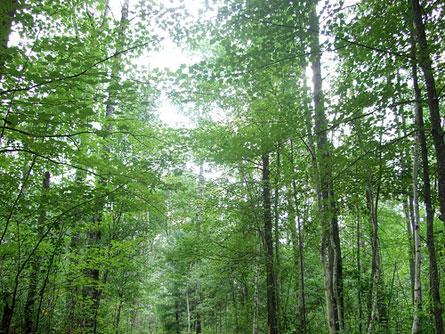Plant gas
Trees, grasses, and other plants may produce the greenhouse gas methane.

Trees and other plants may emit large amounts of methane, a greenhouse gas.
jotily/iStockphoto
Share this:
- Share via email (Opens in new window) Email
- Click to share on Facebook (Opens in new window) Facebook
- Click to share on X (Opens in new window) X
- Click to share on Pinterest (Opens in new window) Pinterest
- Click to share on Reddit (Opens in new window) Reddit
- Share to Google Classroom (Opens in new window) Google Classroom
- Click to print (Opens in new window) Print
By Emily Sohn
You may have never heard of methane, but there’s a lot of it out there. Cows emit the gas, which is produced by bacteria in their stomachs. Methane also wafts up from the wet soils in swamps and rice paddies, where methane-producing microbes live.
Now, an international team of scientists has found another, unexpected natural source of methane: plants. Previously, researchers had thought that it was impossible for plants to make significant amounts of the gas. They had assumed that microbes need to be in environments without oxygen to produce methane.
 |
|
Trees and other plants may emit large amounts of the greenhouse gas methane.
|
| Ryan Wick / Flickr |
Methane is a greenhouse gas, like carbon dioxide. Gases such as methane and carbon dioxide trap heat in Earth’s atmosphere and contribute to global warming.
In their experiments, the scientists used sealed chambers that contained the same concentration of oxygen that Earth’s atmosphere has. They measured the amounts of methane that were released by both living plants and dried plant material, such as fallen leaves.
With the dried plants, the researchers took measurements at temperatures ranging from 30 degrees Celsius (86 Fahrenheit) to 70 degrees C (158 F). At 30 degrees C, they found, a gram of dried material released up to 3 nanograms of methane per hour. (One nanogram is a billionth of a gram.) With every 10-degree rise in temperature, the amount of methane released each hour roughly doubled.
Living plants growing at their normal temperatures released as much as 370 nanograms of methane per gram of plant tissue per hour. Methane emissions tripled when living and dead plant material was exposed to sunlight.
Because there was plenty of oxygen available, it’s unlikely that the types of bacteria that normally make methane were involved. Experiments on plants that were grown in water rather than soil also resulted in methane emissions. That’s another strong sign that the gas came from the plants and not soil microbes.
Altogether, the world’s plants produce more than 150 million metric tons of methane each year, the scientists estimate. That’s 20 percent of all the methane that typically enters the atmosphere.
Future tests will measure how much of an impact plant-produced methane actually has on the environment.
Going Deeper:
Perkins, Sid. 2006. Greenhouse plants? Vegetation may produce methane. Science News 169(Jan. 14):19. Available at http://www.sciencenews.org/articles/20060114/fob1.asp .
You can learn more about the greenhouse effect and gases such as methane at www.epa.gov/globalwarming/kids/greenhouse.html (U.S. Environmental Protection Agency).
Information about natural gas (methane) is available at www.eia.doe.gov/kids/energyfacts/sources/
(Energy Information Administration).






